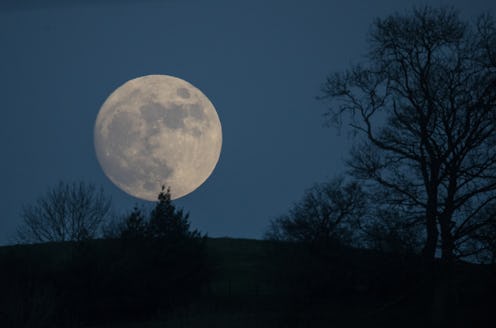Life
Here’s Why The First Full Moon Of 2018 Is Going To Look EXTRA Huge

Get ready to howl at a very full moon this New Year's Day. That's right: The first month of 2018 is going to be off to a pretty interstellar start with not one, but two supermoons set to shine down on all of us during January. The first full moon, which has one of my personal favorite names for a moon ever, will be the Wolf Moon. According to the website Space.com, the January Wolf Moon, is due to peak on Jan. 1, at 9:24 p.m. ET, although we should expect to see a fuller brighter moon over the next few days leading up to the Wolf Moon. And the reason for that is that the 2018 Full Wolf Moon will also be a supermoon — in other words, the moon's planetary alignment puts it at just the right position for it to appear way bigger to us Earthlings.
January's second full moon which is scheduled to make an appearance on January 31, will feature a total lunar eclipse, or a "blood moon."
According to Space.com. "the [Wolf] moon is so bright that it will make the deep sky objects nearby, the Orion nebula, for example, a bit harder to see if the sky isn't perfectly clear. An interesting artifact of celestial motions is that on that first full moon night, none of the traditional naked-eye planets Mercury, Venus, Mars, Jupiter or Saturn will be visible at all from the northeastern U.S. when the moon reaches full phase."
OK, so we're losing sight of Mercury, Venus and Jupiter. NBD, because what we're getting in return is so much better and brighter.
"A supermoon happens when the full moon coincides with the moon's closest approach to Earth in its orbit," according to Space.com. "Supermoons make the moon appear a little brighter and closer than normal, although the difference is hard to spot with the naked eye."
That said, don't think you won't be able to see the supermoon in action, no matter what your location is. "The supermoon may look especially large to you, however, if it's very close to the horizon. But that has nothing to do with astronomy and everything to do with how the human brain works. This effect is called the "moon illusion" and may arise from at least a couple of different things. Scientists suggest that perhaps the brain is comparing the moon to nearby buildings or objects, or perhaps our brain is just wired to process things on the horizon as bigger than things in the sky."
That's right — it's a tricky moon illusion. Still, illusion or not, it's a Wolf Moon so it's going to be rad one way or another.
No matter where you'll be stargazing from on Monday, if you're looking to impress your friends with a bit of trivia or if you're simply wondering where the name Wolf moon came from, there are a couple different trains of thought on the subject. According to Space.com, the Wolf Moon's name comes from a "system of full moon names originally used by New England's native Algonquin tribes." OK, that makes sense. But wolf? The website Timeanddate.com has another theory: "The scientific community has no indication that the Moon phase plays any particular part in the calls of the wolf, but wolves are nocturnal animals, so they are in general more active at night. And wolves do howl in the direction of the Moon; they point their faces toward the sky for better acoustics, because projecting their howl upward carries the sound farther."
Interestingly, the Wolf Moon has a few other interesting nicknames, including the Hay Moon, the Buck Moon, or the Thunder Moon, according to Space.com.